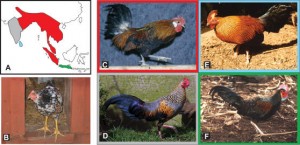In to Africa
We know that chickens descend from red junglefowl of East Asia (with a little bit of those yellow-legged grey junglefowl) but we are still a little uncertain about the timing and circumstances of the chicken’s domestication…
This is because it is difficult to differentiate wild and domestic fowl on the basis of their archaeological remains. The easiest way to be sure that we are dealing with domestic chickens is when we find their bones on sites located beyond the junglefowl’s native range. Different varieties of junglefowl exist across Island Southeast Asia, China and India (see below).

A. Map of South Asia onto which the ranges of four species of junglefowl are drawn.
B. European domestic chicken with yellow legs. Red, grey, blue, and green regions represent the respective ranges of red, grey, Ceylon, and green junglefowls.
C. Red junglefowl. D. Grey junglefowl. E. Ceylon junglefowl. F. Green junglefowl.
(Photo: Figures 1B: Björn Jacobsson; 1C: Erik Bongcam-Rudloff; 1D: John Corder, World Pheasant Association; 1E: Jean Howman, World Pheasant Association; 1F: Kenneth W Fink, World Pheasant Association). Source: Eriksson et al. 2008.
Chickens do not tend to migrate by themselves, so if we find evidence for them in regions beyond those highlighted in Figure 1, it is likely that they were taken to these locations by people. For instance, chickens are not native to Africa but, today, they represent an important part of the culture and economy. So when, and how, did the chicken arrive on the continent?
Since November 2016, we have been undertaking research to answer this question. Our key collaborator has been Dr Helina Woldekiros from Washington University St. Louis. She has been working on archaeological material from the site of Mezber, located in the Tigray region of northern Ethiopia. From this site she has recovered a number of chicken bones, which have been radiocarbon dated to around 819-755 B.C. making them the earliest known chickens in Africa. You can read about her findings here
And we will provide more updates as the results from our ongoing research emerge!
References
Eriksson J, Larson G, Gunnarsson U, Bed'hom B, Tixier-Boichard M, Strömstedt L, Wright D, Jungerius A, Vereijken A, Randi E, Jensen P, Andersson L. Identification of the yellow skin gene reveals a hybrid origin of the domestic chicken. PLoS Genet. 2008 Feb 29;4(2)
Follow us
Keep up to date with the latest project news via our Twitter feed.
- — 5 years 8 months ago
- — 6 years 5 months ago
- — 6 years 6 months ago
- — 6 years 7 months ago

 ChickenCoop
ChickenCoop